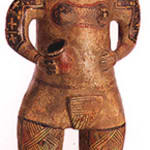Galo Polychrome Standing Female Figure, 500 CE - 1000 CE
Terracotta
29
PF.3570
This standing female figure comes from the Guanacaste-Nicoya polychrome tradition, the galo polychrome style. Its mirror-bright burnished surfaces are technically unsurpassed by any Pre-Columbian pottery, and yellows, reds, oranges, creams,...
This standing female figure comes from the Guanacaste-Nicoya polychrome tradition, the galo polychrome style. Its mirror-bright burnished surfaces are technically unsurpassed by any Pre-Columbian pottery, and yellows, reds, oranges, creams, maroons, and blacks of the polychrome decorations are impressively vivid. Among such sculptures are the full human figures with elaborate representations of tattoos or body paint. Such brilliant polychrome tradition represent an important social dimension; when the northern trade network that brought jade, slate-backed pyrite mirrors, foreign ceramics, and other luxury goods, the Nicoyans responded by producing their own special purpose pottery. Inspired by northern models, it also incorporated local and southern elements, forming a dazzling hybrid style that was traded around Central America and southern Meso-America in the centuries to come. Elaborately decorated with colors and patterns, this large sculpted female stands holding a small jar. A fine example of galo polychrome figures, she provides a wealth of ethnographic detail because of the realistic style. Her coiffure, earspools, and body painting or tattooing are all vividly shown. Elaborate patterns on her breasts emphasize her voluptuous feminine beauty, and she wears a gorgeous tanga, a loincloth. Her large thighs support her body with a sense of stability, as if she is pronouncing her fecundity. The body painting is intricately rendered in a symmetrical manner, further accentuating the refined sculptural quality. As we look at the wonderful sculpture, we wonder what she is doing with the jar in her hand. Perhaps she is on her way to a ritual performance, or perhaps she is going to a funeral ceremony with the offering in the jar. This ancient beauty fascinates us endlessly.



